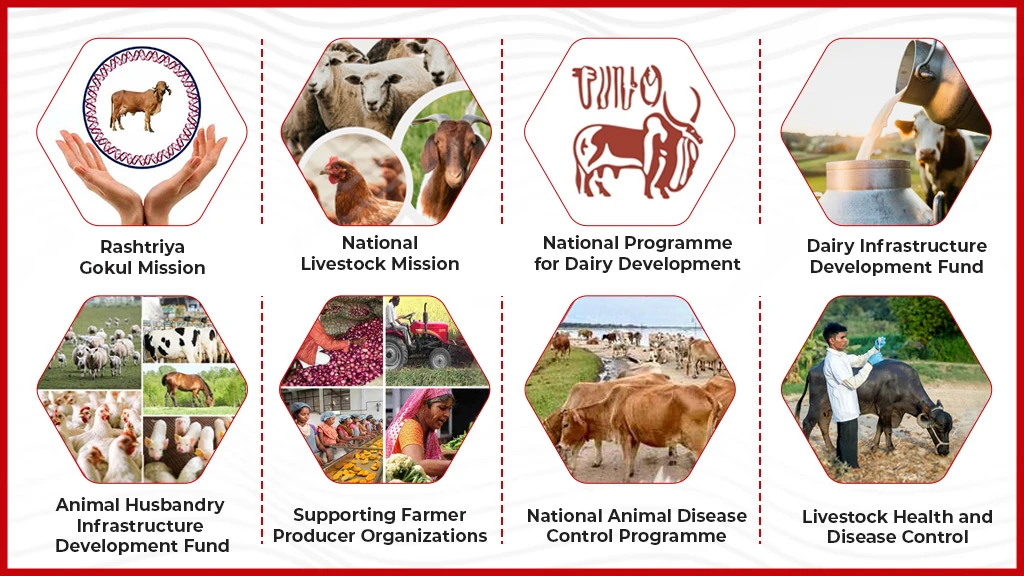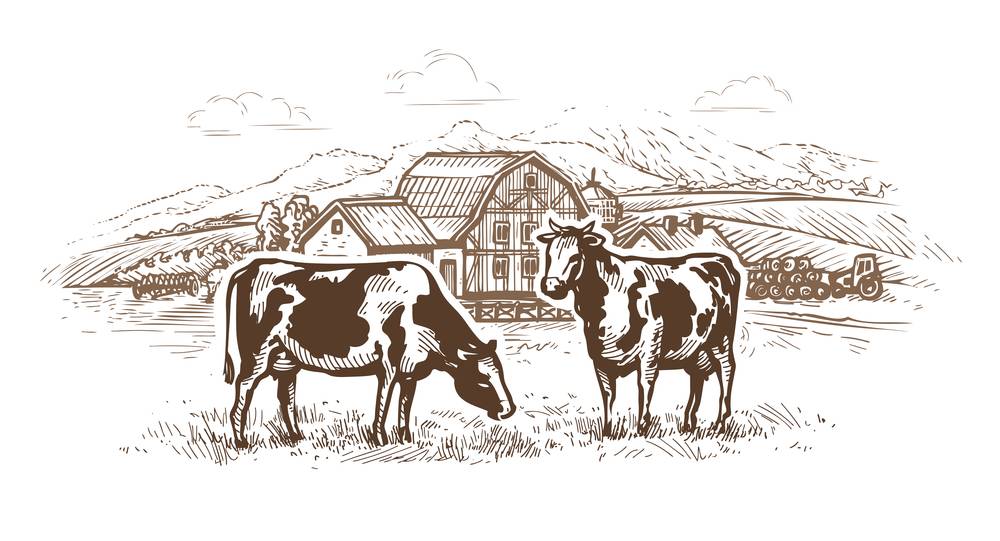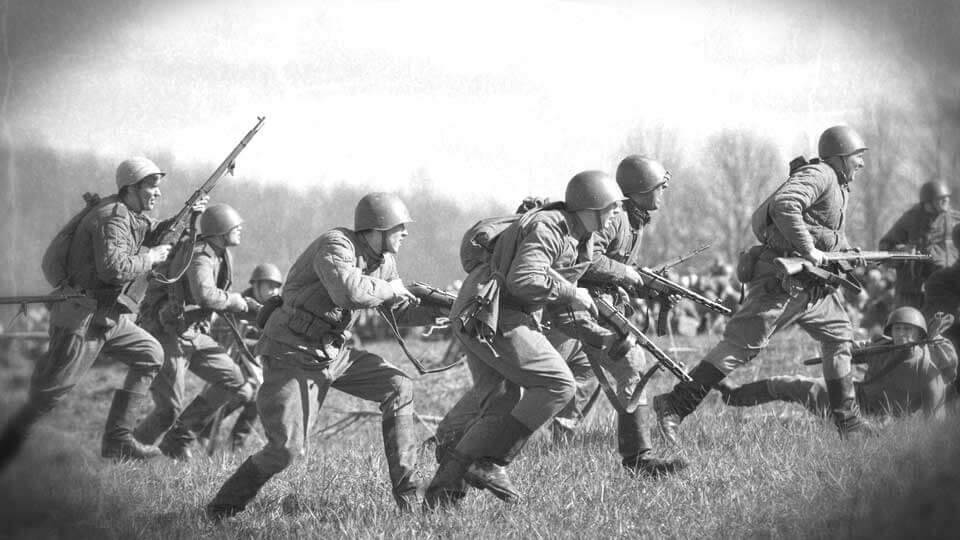ANIMAL HUSBANDRY & FISHERIES
India has the largest and most varied animal resources in the world and it has about 1/6th of the cattle, 1/2 of the buffalo and 1/5th of the goat population in the World. India has a good number of milch breeds, Sahiwal, Red Singhi and Deoni are some of the outstanding breeds.

India has gone for the world’s largest and most ambitious milk programmes called ‘operation flood”.
Drought breeds are poor in milk yields, but the bullocks are excellent draught animals.
About 42% of the cattle in the country are draught animals. India has 3% of the world’s sheep population and ranks 6th among the sheep-breeding countries of the world. Rajasthan has the largest (24%) of India’s total stock. India owns one of the largest livestock
populations in the world.
It accounts for 16% of the cattle population and 57% of buffalo population. India has become the largest producer of milk in the world.
Milch Breeds:
Haryana, Rajasthan, UP and Delhi. The Deoni breed is widely in north western and western parts of Andhra Pradesh.
Drought Breeds :
Notable drought breeds include the Amritmahal, Kanhayam, Ponwar, Bargur, Siri, Hallikar, Khilari, Nagori Bauchaur, and Malvi.
The Bagori breed originated in Jodhpur and may be found throughout much of Rajasthan, Haryana, Uttar Pradesh, and Madhya Pradesh; on the other hand, the Bauchaur breed is primarily found in Bengal.
The Malvi people are mainly found in the arid western regions of Madhya Pradesh.
The Kenkatha or Kenwariya breed is native to the U.P. district of Banda and the neighboring regions of M.P. The Kherigarp breed is found in the U.P. district of Kheri.
While the Halikar and Amritmahal breeds are native to the Karnataka districts of Tumkur, Hassan, and Mysore, they are dispersed throughout the Indian Peninsula.
Sholapur and Satara districts comprise the home of the Khillari breed. The Bargur and the Kangayam breeds are the natives of Coimbatore district of Tamil Nadu.
The Siri grows well in the hilly of Darjeeling and Sikkim
Dual Purpose Breeds:
Cattle of these breeds are used both for milk and for drought purpose. The cows are fairly good yielders of milk while bullocks are good for drought.
Tharparkar, Haryana, Mewati, Kankrej, Rath, Nimari, Dangi, Krishan and Ongole are important breeds of this category.
Exotic Breeds:
Some of the high milk-yielding exotic breeds have been developed in India.
Some foreign breeds have been crossed with India breeds and new breeds called cross breed have been developed.
Some of the important exotic breeds are Jersey, Holstein, Friesian, Swiss-Brown, German Feleckvich and Ayrshire.

Buffalo:
The purpose of raising buffaloes is for milk, about 75% of them. In the moist regions of West Bengal, Assam, Orissa, and Kerala, they are employed for field plowing and drafting as well.
India is the country with the greatest concentration of buffaloes worldwide, in addition to having the most buffaloes overall.
Some notable breeds are the Murrah, Bhadwari, Jaffarabadi, Surti, Mehsana, Nagpuri, and Nili Ravi.
Famous Buffalo Breeds-
Murrah: Indigenous to Rohtak, Hissar and Gurgaon districts of Haryana Delhi and Punjab. The Murrah male buffaloes are good drought animals.
Bhadwari: The Bhadwari breed belongs to Agra and Etawah districts of U.P. and the neighbouring part of Madhya Pradesh and Rajasthan.
Jaffarabadi: The Jaffarabadi breeds hails from the Gir forest of Gujarat. The buffaloes of this breed are quite massive and yield about 2500 kg of milk per lactation, d
Surti: The Surti breed comes from the Gujarat plain. Nili Ravi: The Nili Ravi breed belongs to Ferozepur district of Punjab. Nagpuri: From Vidarbha region of Maharashtra.
Cow & Oxen:
Some important indigenous breeds are:
Gir: From Saurashtra. Red Sindhi: From Gujarat, Rajasthan and Maharashtra.
Sahiwal: From Delhi, Punjab, Haryana, Rajasthan and western U.P. Deoni: From Andhra Pradesh.
Nagori: Drought breed of Rajasthan. Bachaur: Drought breed of Bihar.
Kenkatha/Kenwaria: Drought bread from Kiu Valley in Banda district of U.P. Amritmahal/Hallikar: Drought breed from Karnataka.
Siri: Drought breed of Darjeeling and Sikkim. Ongole: Drought breed of Guntur district of Andhra Pradesh.

In terms of cows and oxen population M.P. (including Chhattisgarh) ranks first followed by Uttar Pradesh (including Uttaranchal), Bihar (including Jharkhand), West Bengal.
In terms of cow milk production Uttar Pradesh (including Uttaranchal) ranks first followed by west Bengal, Maharashtra and Tamil Nadu.
Sheep:
After Australia, Russia, China, Argentina, and New Zealand, India has the sixth-largest sheep population in the world.
The majority of sheep raised in India account for about 4% of all sheep worldwide; these sheep are typically raised in areas that are too arid, stony, or mountainous to be suitable for agriculture or raising cattle. India has a large population of low-quality sheep that produce less wool overall.
Additionally, they produce very little mutton. Nonetheless, the northern temperate zone is home to some excellent breeds.
Sheep are a significant part of our economy simply by virtue of their sheer number; they give us wool, mutton, and skins. investigated by segmenting the sheep habitats into the subsequent areas:
The distribution of sheep may be properly Temperate Himalayan Region:
It comprises Jammu and Kashmir, Himachal Pradesh and Uttarakhand. The entire region has temperate climate which is quite suitable for good quality sheep.
The excellent pastures exist on the hill slopes. India’s best quality sheep are reared in the Kula, Kangra, Chamba and Kashmir valley at altitudes varying from 2000 to 3000 m.
Dry North-Western Region: This region includes Rajasthan and neighboring parts of Punjab, Haryana, Western Uttar Pradesh, Gujarat and Madhya Pradesh.
There are more than 13 million sheep contributing to about half of the total wool production of India, however the wool is of comparatively inferior quality and the yield of wool per
sheep is lower than that of the Himalayan.
Marwari breed of Rajasthan is famous for its wool.
Semi-arid Southern Region:
This region, comprising Maharashtra, Karnataka, Andhra Pradesh. Tamil Nadu and parts of Madhya Pradesh, supports half the total number of sheep found in India.
In spite of the largest numbers of sheep about 50 percent of the sheep of this region are raised for mutton and produce no wool.

Humid Eastern Region:
This region comprising Bihar, West Bengal, Assam and Orissa, has humid climate which is not favorable for sheep rearing. The sheep are mainly reared for producing mutton.
In terms of sheep population Rajasthan ranks first followed by Andhra Pradesh, Tamil Nadu and Karnataka.
Goat:
Goat is called the poor man’s cow because it can be cheaply reared on meagre grass of poor quality. It is the major supplier of mutton along with milk, hair and skins.
Goats are found in larger number as compared to sheep and are next only to cattle.
Goat rearing accounts for about one-sixth of the global goat population. Although they are found practically everywhere in the nation, Bihar (17.31 million), West Bengal (14.17 million), and Uttar Pradesh (13.11 million) have the largest concentrations of goats.
Over half of all goats in India are found in these states. Certain exceptional breeds are exclusive to particular regions.
Raised in Kashmir and Himachal Pradesh, the Himalayan or Angora goat is sometimes referred to as the Chamba, Gaddi, Chegu, or Kashmiri breed. Sach creates warm, silky hair. Famous across the world are the Pashminas raised in Kashmir and the Kullu Valley.
because of its mohair, a type of pashmina fur. The breed that can be found between the Yamuna and Chambal rivers is the Jamunapuri.
It is dual purpose breed providing meat and milk. Among the other breeds are the Beetal of Punjab, of the Marwari, Mehsana, Kathiawar and Zalwadi of Rajasthan Gujarat and Madhya Pradesh and the Barari, Suru and Deccani of the Peninsular India.
Several important foreign breeds such as Alpine, Nubian, Saanen, Toggenberg and Angora have been used for cross breeding with the local breeds.
Pigs:
There are about 100 lakh pigs providing about 5 per cent of India’s meat production in the form of pork.
In a poor and thickly populated country like India, pig rearing is an important activity because pig provides rich meat at low cost.
Pig farming plays in important role in improving the socio-economic status of sizeable section of weaker rural communities especially in northeastern states where every rural family rears pigs for meat.
Horses and Ponies :
About one fourth of the total horses and ponies are found Uttar
Pradesh, Bihar and Jammu and Kashmir. Some of the important indigenous breeds include Marwari, Kathiawari,
Manipuri, Bhutani, Spiti and Chummarti.
► Donkey and Mules :
Donkey and mules are used as beasts of Burden, especially in those areas where modern modes of transportation cannot be used.
Most of the donkeys are found in Rajasthan, Uttar Pradesh, Punjab, Gujarat and Tamil Nadu. Mules are derived from the crossbreeding of mares and donkeys.
The largest concentration of mules is found in Uttar Pradesh and West Bengal. In terms of goat population Bihar (including Jharkhand) ranks first followed by Rajasthan, West Bengal and Uttar Pradesh (including Uttaranchal).
Uttar Pradesh, which includes Uttaranchal, ranks #1 in terms of goat milk output, followed by
Bihar (includes Jharkhand), Rajasthan, and the erstwhile M.P. Andhra Pradesh is the top state in terms of the number of hens and ducks, followed by West Bengal, Maharashtra, and Tamil Nadu.
Uttar Pradesh (including Uttaranchal) leads the country in terms of total milk output, followed by Rajasthan, Bihar (including Jharkhand), and Madhya Pradesh (including Chhattisgarh).
Rajasthan is the top producing state for wool, followed by Jammu & Kashmir, Gujarat, and Karnataka.
Camels:
The camel is known as the “ship of the desert” and is a very helpful animal in dry areas for transportation and drought relief.
The majority of camels—roughly two thirds—are found in Rajasthan alone.
The rest of the camels are found in the arid semiarid areas of Punjab, Haryana and Gujarat.




